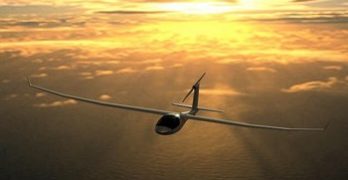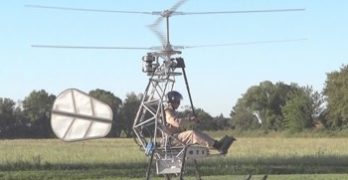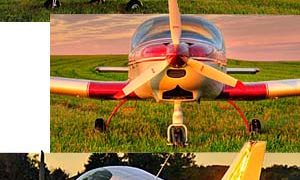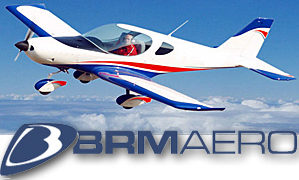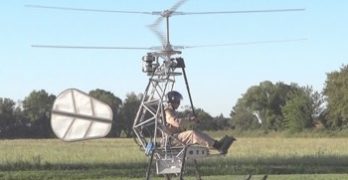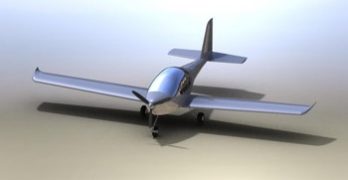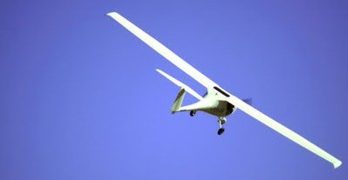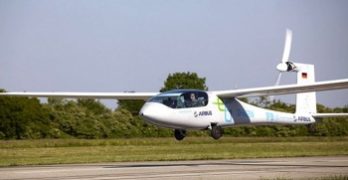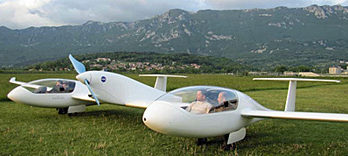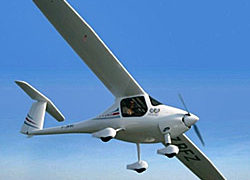Updates 10/4/11 and 10/5/11 — Congratulations to Pipistrel for their unprecedented third win at a NASA Challenge. Picking up a cool $1.35 million, the company won with their unorthodox dual Taurus G2 fuselages joined by a larger, centrally-mounted electric engine. The custom-configured, four-seat aircraft achieved an amazing 403 passenger miles per gallon of fuel (or its equivalent). After this string of wins, Pipistrel has firmly placed itself in the lead position among highly efficient light aircraft and those powered with electric motors. *** NASA claims the prize purse was the biggest ever awarded for an aviation competition. In second-place a much smaller but still hefty check for $120,000 went to the German eGenius team, NASA announced. *** Read more from our friends at AvWeb and at Flying online. In addition, Aero-News offers a video with more on the potential of electric power (scroll to or search for “The Green Flight Challenge”).
Search Results for : motorglider
Not finding exactly what you expected? Try our advanced search option.
Select a manufacturer to go straight to all our content about that manufacturer.
Select an aircraft model to go straight to all our content about that model.
Electric Whirlybird Flies!
Anyone still in doubt that we’re in the midst of the birth of electric flight need look no further than this story, just posted today on the online tech zine Gizmag.Pascal Chretien, an enterprising electrical/aerospace engineer and chopper pilot, made the world’s first fully electric helicopter flight in the prototype he designed and built almost entirely by himself…in just 12 months! Hang glider and ultralight trike pilots will delight in hearing a weight shift control system is involved. *** For me, the big story here is once again we see that innovation lives, not just in megabuck corporate and government R&D departments but in the garages of individual megabrains as well…as it always has and we can expect always will.Chretien, in making his 2 minute, 10 second test eggbeater flight, threw whipped eggs in Sikorsky’s face since that aviation giant’s well-funded electric project, in development for some time now, has yet to fly.
A Pair of New SLSA Arrive Before AOPA Summit 2011
Just in time for this year’s AOPA Summit, welcome to a pair of Special Light-Sport Aircraft, numbers 121 and 122: the first, the formerly named NG 5 LSA, rebadged as the Bristell Fastback by importer Liberty Sport Aviation of Pennsylvania; and the second being the fourth approval for Pipistrel, specifically for their Sinus motorglider (previous Pipistrel approvals included the Virus, Virus SW, and Taurus). *** NG 5 LSA was not previously offered in the U.S. though it was sold in Europe as the NG 4 from Roko Aero. When Roko closed its doors production stopped for the NG 4. It became NG 5 as the company reformed into BRM Aero. Changes occur in any industry but Bristell Fastback designer, Milan Bristela, is a steady hand on the joystick known for his foundational work on the SportCruiser (for a year known as the PiperSport) that is presently ranked #2 in U.S.
Two New (Yet Familiar) LSA Return to America
Here’s a tale of two planes. One has been seen and sold in the U.S. (Lambada motorglider). The other has a fascinating history and should look familiar to you… quite familiar. It’s now known as the NG 5 LSA and that probably rings no bell. However, NG 5 and the #2 ranked SportCruiser share a common history. NG 5 designer, Milan Bristela, once lead design work at Czech Aircraft Works, the first company to create and bring to market the SportCruiser. In 2010 that model took a yearlong debut as the PiperSport though once again U.S. Sport Aviation returns to their long support for and sales of SportCruiser, now produced by Czech Sport Aircraft. *** Along the way, Milan departed and worked for a time with another company called Roko Aero; the aircraft was then called the NG 4. The newly formed BRM Aero company said, “[We] finished collaboration with Roko Aero and stopped production of their NG 4 aeroplanes.” Now, Americans can welcome NG 5 LSA to be represented by Liberty Sport Aviation in Pennsylvania.
Electric Whirlybird Flies!
Anyone still in doubt that we’re in the midst of the birth of electric flight need look no further than this story, just posted today on the online tech zine Gizmag.Pascal Chretien, an enterprising electrical/aerospace engineer and chopper pilot, made the world’s first fully electric helicopter flight in the prototype he designed and built almost entirely by himself… in just 12 months! Hang glider and ultralight trike pilots will delight in hearing a weight shift control system is involved. *** For me, the big story here is once again we see that innovation lives, not just in megabuck corporate and government R&D departments but in the garages of individual megabrains as well…as it always has and we can expect always will.Chretien, in making his 2 minute, 10 second test eggbeater flight, threw whipped eggs in Sikorsky’s face since that aviation giant’s well-funded electric project, in development for some time now, has yet to fly.
Power To/From the People!
Stephan Boutenko has a big vision…and he’s taking it to E-street. *** Anyone familiar with Bend, Oregon’s Lance Niebauer, the successful Los Angeles graphic artist who decided to design an airplane and spawned the highly successful Lancair series of homebuilts, which evolved into the production Cessna Columbia composite four-seater, should check out another Oregonian with a big dream: Stephan Boutenko. *** He’s boldly going directly to the internet for public contributions to fund his electric S-LSA. The company name is Alternair, and the airplane is simply called the Amp — perhaps an unintentional play on the word imp, because it is a cute little thing…but with big dreams in its electric heart. *** A professional pilot and Embry Riddle grad with an Professional Aeronautical design degree, Boutenko hopes to progress the current electric-powered aircraft technology beyond demonstration-style or exotic motorglider models. *** The Amp, still in the design stages, will perform comparably to the current crop of gasoline-powered LSA…at as little as 80% lower direct operating costs.
Oshkosh Airventure 2011
After my own Labors of Hercules, I arrived at the EAA Oshkosh Airventure seasonal highpoint event Tuesday mid day. Since it was a beautiful day by anybody’s standards, I decided not to brave the hordes at the show and headed out, once I got settled in my digs for the week, to a lovely little airport named Brennand about 10 minutes northwest of EAA’s Wittman Field show grounds. *** I was in luck with more than just weather: the San Antonio Light Sport Aircraft (SALSA) gang from Texas was there demo-flying its all-composite Pipistrel Virus SW 80/100, tricycle-gear (there’s also a taildragger version), composite touring motorglider. *** The Pipistrel line includes several designs I have admired from afar but not had the opportunity to share air with. *** All that changed when Salsa’s prime mover and shaker Rand Vollmer introduced me to a big, friendly Texican fella named Dave White.
eWow! Blockbuster Electric Flight
A crack team of aeronautical whizbrains in the Institute of Aircraft Design at the University of Stuttgart, Germany has just passed its second important milestone in less than two months: its electric aircraft eGenius just flew more than two hours at more than 100 mph. *** Not by coincidence, that’s exactly the kind of performance that will be required to take $1.3 million top prize in the recently postponed (until September 25) CAFE Green Flight Challenge. *** The GFC will award the prize money to the aircraft that can fly 200 miles at greater than 100 mph on the equivalent of one gallon of gas per occupant. The per occupant proviso is significant…and EGenius carries two people, so it can use enough batteries to store two gallons worth of energy. *** That’s a lot of batteries given the current relative inefficiency of energy storage of batts vs.
Pipistrel’s Twin Taurus… Could They Win Again?
Question: What looks like two motorgliders flying in really tight formation sharing an engine… er, a motor, literally between them? Can this Burt Rutan-looking aircraft (photo) win the big dough? And I mean seriously big money with a purse of $1,650,000! *** Called the Pipistrel Taurus G4, the prize-seeking aircraft rolled out of the Pipistrel factory in Slovenia for the first time recently. After posing briefly for the camera, G4 taxied away quietly under electric power for the start of the flight testing program. *** Pipistrel previously won a big NASA check with their Virus SW but the company has now taken a wholly different approach, based on rules which give seat-mile advantage to four seater models. *** “This aircraft is the first four-place electric aircraft to be flown in the world,” stated Pipistrel. Their Taurus Electro claimed to be the first two-place electric aircraft to be flown in the world four years earlier.
Triple Play: Pipistrel Wins SLSA Approvals
After a pause in new SLSA, Pipistrel burst onto the scene with multiple approvals, three at once reports Michael Coates, the importer for Pipistrel USA. We raced to get these placed on the SLSA List because it’s news, but also because FAA uses this list to verify new models before assigning them N-numbers. FAA Registration Branch checks to make sure company names and other info matches incoming applications; we had three calls last week from producers who requested minor changes to our SLSA List after the agency raised questions. *** Now that list swells to 118 models. Pipistrel, which makes long-winged models that soar well, got the Virus approved in both airplane and glider categories, no small achievement. They also gained approval for their Taurus motorglider. The Slovenian company — with production facilities in nearby Italy (partly an effort to adhere to the U.S. government’s bilateral agreement requirement… dull, yes, but important legally) — has been in the news for their electric airplanes and has announced a supersleek four seater, the Panthera.
- « Previous Page
- 1
- …
- 14
- 15
- 16
- 17
- 18
- …
- 23
- Next Page »


